Fulwell Golf Club - Stand and Deliver ...
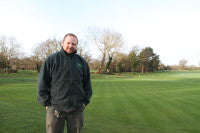
Fulwell Golf Course lies in the corner of what formerly was Hounslow Heath, the notorious haunt of highwaymen. Golf began at Fulwell in 1904 on the original layout designed by the then professional at (not yet Royal) Mid-Surrey, J.H. Taylor, Open winner and part of the legendary "Great Triumvirate". He created a par 80 'outer' men's course and an 'inner' ladies course measuring 5,000 yards.
In 1921, Dr Alistair Mackenzie was employed to extend and improve the men's course with, after World War II, John S. F. Morrison designing an 18 hole course made up of eight of the original "outer" layout and ten new holes from the land previously occupied by the "inner" ladies course; the inner having been given over to growing vegetables to support the war effort. This is the course pretty much as it is today.

The club is situated only two miles from Twickenham Stadium, the home of England rugby and, although early January is probably not the best time of the year to be visiting a golf course, as I had been to see the RFU's Keith Kent, it seemed the perfect opportunity to meet up with the club's Course Manager, Paul Brown and his team.
On my arrival, I was immediately impressed by, what I thought were, brand new workshop and mess room facilities, only to find out that they had been constructed six years ago. Everywhere was immaculately clean; you could eat your dinner off the floor!
Paul explains that he has a strict policy of keeping things tidy; everything has a place. The mess facilities were spotless, no one is allowed in with dirty shoes - even the sales reps have to take off their shoes before entering!
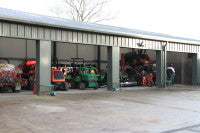
"During the first year, we spent a few months in each department, one of which was the sports grounds and, in particular, the local bowling greens. This is what sparked my interest in turf and, as soon as my year was up, I went for a job at Datchet Golf Club where I learned the basic greenkeeping skills from the Head Greenkeeper, Neville Roe. He encouraged me to move on to gain more experience and I was lucky enough to get a job at Wentworth, helping grow in the Edinburgh course, which was a fabulous experience."
"I then moved to Burnham Beeches Golf Club and, from there, to my first senior role as a Deputy at Flackwell Heath Golf Club. I learned so much from the Head Greenkeeper, Lee Robinson, and will be forever grateful to him for all the knowledge he handed down to me. When he left for pastures new, the club gave me the opportunity to show them what I could do and I ended up staying for ten years before moving to my current position."
"Working at five clubs during my career, all with vastly different soil types, layouts, resources and aspirations, has given me a very firm knowledge base from which to work," continues Paul. "Much of my training was prior to the NVQ system and was done under the City & Guilds scheme at the Berkshire College of Agriculture. I also did a National Technical Certificate at Sparsholt College. I also have the obligatory chainsaw, spraying and first aid certificates but, undoubtedly, it was Lee, who is now the Course Manager at Gerrards Cross Golf Club, who helped shape my career and greenkeeping philosophy."
P
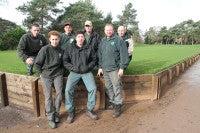
Assistant Greenkeepers Chris Fogg and Sean Eckett, and trainees Will Turner and Alex Bueno complete the greenkeeping team, with Michael Lipscombe, a recently employed mechanic/technician, being the other fifty-something. "Since Michael joined the team last year, we have had no requirement, as yet, to call on any outside technicians. It is an appointment that has proved very cost effective," confirms Paul.
"I have all my staff trained and assessed to NPTC standard for all machinery and, where appropriate, pesticide, chainsaw and first aid. As a club, we hold regular H&S meetings, with all departments in attendance, and are presently streamlining our methods by using an online system. We actively encourage the staff to get involved in their own H&S, such as the risk assessment process and identifying new hazards."
"As a club, we encourage the greenstaff to go out and look at what training is available. They then come back to us with the details and an indication of the benefits it will bring to both themselves and us as an employer."

"I sit down each year with the secretary and finance chair after producing a spend forecast and reviewing the five year capital/machinery plan," he explains.
"We have recently overhauled the way we set our budgets and have introduced much more detail into them, so they are now a better reflection of what and where we spend and, therefore, I can more accurately forecast for the future. Ultimately, I am responsible for working within the defined budget we set as a group and highlighting any areas that may need additional resource going forward."
"As with every aspect of expenditure, the end result has to justify the initial outlay but, sometimes this can be difficult for club officials and members to see. Education and communication are the key factors here, demonstrating that our methods work and targets are met. Weekly performance testing and regular testing of our soils ensure we are effectively managing our resources."
The course covers 132 acres in total, twelve of which are managed ecological rough, thirty-five mature woodland and eighty-five the playing area.

"With the changing weather patterns, we are definitely starting to struggle a little more during the winter period with high moisture levels. The rapid changes from dry to wet periods and back again have also presented some challenges, as water often appears in traditionally dry areas of the course and vice versa due to changes in underground water patterns."
Having experimented with drainage over the past fifty years, the club have concluded that it is virtually impossible to utilise a piped system effectively without significant investment, although that hasn't stopped them from actively looking at long term solutions. "We have recently commissioned an in-depth drainage scheme for the entire course, alongside a comprehensive course audit to include a full bunker redesign and some substantial changes to several holes."
"The greens are all original push up with no drainage; the exception being the 18th, which was rebuilt in 2008 to a USGA construction specification, but utilising a slightly slower draining rootzone to help it match the existing greens performance a little closer."
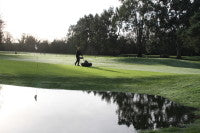
"The 18th green has required intensive hollow coring as we used the original turf during construction, and this has caused some issues with moisture retention in the top profile. This has required an intensive hollow coring and soil exchange programme, but we have seen the percentage of moisture recorded in the top 20mm fall as a result."
"Organic matter reduction has been our primary focus over the last few years and, using a combination of our Graden sand injection machine, hollow coring, deep scarification and increased amounts of topdressing, we have seen recorded levels drop from almost 11% in the upper 20mm profile to 4%. Similarly, organic matter levels further down the rootzone profile have also dropped from 9% to under 4%. This has required a great effort from my staff and many hours of hard work, but the results are there to see," Paul confirms proudly.
"Around half the tees have been reconstructed during my time here. We have found that, providing we use a minimum of 250mm rootzone over our native soil, there is no requirement for additional drainage. The remainder are simple push up tees with no drainage."
During wet spells, Paul often closes holes and makes up a composite course as best he can. "This allows the membership to play at least some golf," he says, "and I know they appreciate the effort we put in to try to keep the course open. Doing so, however, causes some problems with extra wear on the drier holes and often requires more extreme remedial work in the spring."
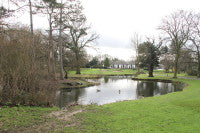
Fortunately for Paul, the members have come round to his way of thinking. "Shade and a lack of air movement around greens, in particular, has been an issue since I arrived at Fulwell. At first, there was considerable resistance to the removal of, what I would term, scrub, but what the membership termed as trees! Over a period of time, and several question and answer sessions in the clubhouse, we eventually got the point across that preservation is not conservation and there was, indeed, a big difference. Nowadays, the membership actively encourage us to thin out encroachment, which is quite a change of mindset!"
Dr Tim Lodge provides consultant agronomy services. "We have built up a great understanding in the short period of time we have been working together. He is a down to earth, practical consultant which I very much appreciate. Our relationship is possibly one of the most important, and it's great that we both share the same greenkeeping philosophy. He has helped us through the nematode problems we have experienced recently, and was very positive about the situation with both the greenkeeping team and the club themselves, which helped enormously."
Contract spraying of fairways and rough is carried out when required, as Paul finds it more cost effective. The groundwork and soil moving phases of any construction are also outsourced, but installation of rootzone, turf etc., is undertaken in-house.
The club has used Lakes and Greens to maintain the irrigation system for many years. "Their guys know their way around our system, its nuances and give us a great service. We have full irrigation on greens, tees, aprons and fairways. The system runs from a two wire Toro Gemini controller," explains Paul.
Where ongoing maintenance is concerned, the team mow the greens everyday during the growing season, keeping to a height of 3.5-4mm. Tees and approaches (10mm), fairways (12-15mm) and collars (15mm) are mown three times a week and the semi rough weekly at 60mm.
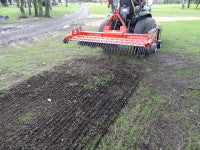
Some form of aeration is carried out every week during the growing season, comprising weekly sarrel rolling, pencil tining every ten to fourteen days and monthly use of the Wiedenmann TerraSpike, using 8 or 12mm tines to at least 150mm.
Graden sand injection is carried out in March and August, often in conjunction with hollow tining, with the TerraSpike - 25mm tines to at least 250mm using heave, as required.
"Our fertiliser programme is based around an early season granular feed," continues Paul, "supplemented by liquid and foliar feeds throughout the season, before finishing with a high K ratio granular. I use a lot of seaweed and tend to use it in most of my tank mixes."
"I'm also a big advocate of keeping the plant healthy by utilising biostimulants of various forms. Phosphites seem to be the fashionable thing at the moment, but I've been using them for a long time with great results."
"Fairways are fertilised as required; normally every spring. We have a significant amount of dwarf rye within the fairway sward and this helps to see it through a very busy playing season."
"Wetting agents are used extensively, with monthly applications of penetrants, such as Floratine Pervade, throughout the winter and a retentive product during the summer months."

"Topdressing is carried out as often as possible, sometimes weekly, but generally, due to time constraints, every ten days or so. Our target application rate for the season is 250 tonnes over 1.2 hectares of greens. However, this will be the first full year utilising our new Wiedenmann core recycler, so the money we save on topdressing will be spent on increased applications to tees."
"Presentation is everything," stresses Paul. "Having said that, it cannot take precedence over agronomics, as that can lead to a very slippery slope. As with all things in greenkeeping, getting the balance right between what the members expect to see and what the turf requires is key."
"We are lucky enough to have two weeks a year where the course is effectively 'ours'. We generally close nine holes and keep the other nine available for play. By doing this, we maximise our productivity and minimise the disruption to the membership. We are also able to carry out our renovations when they are best suited to the plant's needs rather than the golfer's!"
"We have continued to look at ways we can reduce our renovation costs, and one recently purchased machine - a Wiedenmann Core Recycler - is making a difference. We wanted to cut the cost of renovation materials for our greens to allow us to divert that resource to other parts of the course, whilst also streamlining our labour requirements for renovations. This machine has certainly achieved that."
"Prior to th

With this machine, we can do all greens, tees, aprons and collars in our maintenance week with half the labour resource and 60% less materials, which we are recycling back into the sward."
"Over a period of time, the savings will really add up but, more than this, I believe the benefits of recycling dressing are worth it on their own. Thinking about it, we all spend years applying expensive, sterile topdressing to our playing areas, making it biologically active and getting the nutrient balance right, and then we core it out and throw it away or compost it! It just doesn't make agronomic or economic sense."
On such an extensive site, I ask Paul if the team are responsible for all areas. "We have considerable blocks of woodland that we are presently working our way through, thinning and replanting. All of the 'in play' blocks of woodland will be completed this year."
"When I arrived at the club, there was an abundance of Leylandii and Eucalyptus which, in most people's opinion, are simply inappropriate for golf courses, so we set about removing them. I also commissioned John Nicholson to carry out a full survey and have been working from that document ever since."
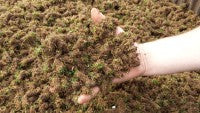
Paul says that keeping the members informed is vitally important. "We have regular forums in the clubhouse which are generally well attended by the members. Sometimes, these can become difficult, particularly if things aren't going well out on the course for whatever reason, but over the years we have learned how to manage these situations and, in any case, I feel it's very important that any course manager has a chance to explain what the issues are and how they will be resolved. I've always felt that the membership go away feeling confident in the greenstaff's ability to get the job done and with more understanding of the challenges we face on a daily basis."
"We also hold regular open evenings in our maintenance facility, of which we are very proud as a club. All our machinery is put on display, with information on its purpose, service life, value etc. The club provides food and drink, and the four hours we normally spend talking to members is gone in a flash! These meetings are probably the most useful communication tool I've come across."
"We also have a course information line and a section on the club's website to communicate daily with the membership."

This philosophy extends to the extensive array of machinery and equipment, which is also kept spotless thanks to a fairly new washdown area that is compliant with current legislation. "It has proved to be one of the best investments the club has made. Our yard space in the old maintenance facility was always a bog of mud and grass clippings, but now it never gets dirty at all. At the end of the working day, we wash the pad and the first person to use it the following day drains the sand debris from the catch tank and the system is good to go. The sump itself is cleaned out every week and, so far, it has proved to be a reliable system with no major problems during its six years service."
"We also estimate an annual water saving of around £2k using the recycled water. The only downside we have found is that it can dull the paintwork on the machinery due to the very small sand particles that escape the system filters, but that's a very small price to pay. The guys have quickly learned not to wash their own cars with it!"

"We have a mix of John Deere and Jacobsen machinery for our front line mowing applications and I think the blend works very well for us. I have used the John Deere equipment for a long time, as the parts back up is simply the best in the industry. The Jacobsen equipment is much newer and has proved to be very reliable over the last three or four years."
For all the other applications, we use a broad mix of machinery, but I have found the five Wiedenmann machines we have to be particularly good. So much so, we are just about to take delivery of a sixth machine, a folding Terrabrush for fairways."
"Our Graden sand injector has been a massive help in reducing our organic matter levels. It's probably the one machine all the guys dislike using because they know the work involved around it!"

We use it for light scarification of our fairways and roughs, for loosening any imbedded or stuck leaf material in the sward and for standing up any flattened grass after the initial cut of our eco rough. We have also found it really useful for clearing up under our numerous Scots and Corsican pines. The needles from these trees are very difficult to blow, as they have little surface area, so we rake them into windrows with the Terrarake and pick them up with our Wiedenmann Super 500. It has turned a task that took hours by hand to complete into a one man, efficient operation."
Weed and pest control on the larger areas, such as fairways and rough is undertaken by local contractors. Weed Management, as Paul finds this both cost effective and limits the exposure to pesticides.
In an ideal world, Paul would like six new hand mowers and the time to be able to hand cut on a regular basis. "The perception people have of hand cut greens being superior has never gone away," he says. "However, I still maintain that a green, cut with a triple mower, performs equally as good and our performance testing proves this, so it's hard to justify the extra time required."
"I'd like a decent lathe for the workshop to allow us to be able to make up parts as required, and a couple of extra tractors would be very useful, as we seem to be constantly changing implements over from one to another."
"Other than machinery, I'd like a decent drainage system to put us in control and not spend half the year in the lap of the Gods!"
As we conclude, and it's time for me to put my shoes back on, I ask Paul what changes he has seen in his time in the industry. "We are certainly in different position than we were when I started greenkeeping thirty-two years ago! We are better respected as professionals but, without a doubt, there is still a large proportion of people that will never recognise that. I don't think a week goes by without someone at the club reinforcing that belief. I don't think that will change anytime soon. That's just the nature of things, despite the best efforts of everybody involved in the industry. The R&A and BIGGA have made enormous strides in changing and challenging the average golfer's perception of sportsturf management, but more credit needs to be given to greenkeepers and groundsmen themselves for taking up the challenge to educate themselves and go about their business in a thoroughly professional manner."
"Generally, and unfortunately, I'd have to say we are still undervalued a good deal of the time, although the club officials here at Fulwell recognise the commitment we put in as a team and the challenges we face on this particular site, so I'm very lucky. They always back my decisions fully, and that has helped us move forward."

Fulwell and the environment
As custodians of a piece of open land in west London, we have a duty and responsibility to create the best possible habitat we can for wildlife whilst, at the same time, providing a great product for our membership.
I believe golfers, in general, are just starting to realise that a great, well managed local environment can really enhance their golfing experience and not detract from it. Limiting your environmental impact doesn't just mean big, high profile projects that take up valuable resource. Small changes to working practices can make a massive difference, they just require a little thought and minimal effort.
Whilst we don't currently have an environmental policy in place, it is 'work in progress' to further enhance our course policy document, although there is already a small section within that document relating to the environment, our minimal use of pesticide policy etc.
We plan to get more involved with Richmond Biodiversity Group once our environmental policy is in place and may consider using the services of an environmental consultant in the future
During my time here at Fulwell, we have quietly gone about doing bits here and there. For many years, when I walked the dog on the course, I would often take a spade with me and build little stag beetle habitats and hedgehog hides within the woodland blocks. Just one a week, but it soon adds up. I didn't see a hedgehog on the course for many years, and it was exciting to see the first one in 2010. The same with stag beetles, of which we have seen many more over the last few years, so it's nice to know the work is paying off and having an impact on these diminishing species.
We are also now in a position to be able to further refine our eco roughs, none of which was here before I arrived. As a result of the introduction of these areas, we have a breeding pair of little owls that have been here for the last four years, and a pair of sparrowhawks that can be seen regularly on the course during the day.
Plans are also in place for a major drainage scheme that involves the construction of some large reservoirs to make us at least, partly self-sustainable for our irrigation requirements.

John Deere 2500
John Deere 2500a
John Deere 2500e
Jacobsen G Plex3
Smithco Tournament Turf Iron
Truturf Turf Iron
Greentek Vibratory Rollers
John Deere 2653a
John Deere 1445 c/w Lastec Articulating Deck + Trimax Flail
John Deere 3235c
Jacobsen LF 550
Jacobsen AR 522
Ferris IS5200 Zero Turn
Bernhards Express Dual 4000 Cylinder Grinder
Bernhards Anglemaster 4000 Bedknife Grinder
Bernhards Two Post Workshop Lift
John Deere 3320 Compact Tractor
John Deere 4520 Tractor
John Deere 4710 c/w Loader
Wiedenmann Super 500
Wiedenmann XP6 Deep Tine Aerator
John Deere 1500 Aercore
Blec Groundbreaker
Charterhouse Vertiseeder
Blec Fairway Overseeder
Wiedenmann TerraRake
Wiedenmann TerraBrush c/w Folding Wing Units
Wiedenmann Mega Twister Blower
Wiedenmann Core Recycler
Turfmech TM360 Blower
Tycrop Propass Mounted Topdresser
Kensett TB220 Brush
Greentek Cassette Chassis x 2 sets
Greentek Sarel Rollers
Greentek Slitters
Greentek Deep Slicers
Greentek Top dressing Brushes
Greentek Rotary Brushes
Greentek Verticutters
Greentek Poa Busters
Greentek Scarifiers
John Deere Progator
Gambetti Barre Truck Mounted Sprayer
Gambetti Barre Tractor Mounted Sprayer
John Deere E Gator
John Deere 4x2 Gator
John Deere TS Gator
Kawasaki Mule
Echo Bearcat 9" Woodchipper
RTS Sarel Roller
Billy Goat Force F1302 Blower x 2
Husqvarna Chainsaws x 5
Stihl BR600 x 3
Stihl BR500
Stihl FS56R Strimmers x 4
Stihl KM 90 Combi Units x 2 + Attachments
Stihl Long Reach Hedgecutters x 2
Rockworth Generator
Greentek Easyload Trailer
Marston 3 Tonne Trailer x 2
TFM Gator Trailer
SCH Gator Trailer x 2
Nissan Navara Pick Up Truck
